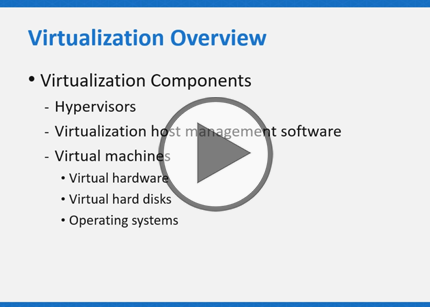Course description
Monitoring resources is an important duty in any environment, but it’s even more vital when in the cloud. Crucial to ensuring the existence and implementation of effective services, we’ll take a closer look at monitoring and monitoring techniques, as well as the different protocols and the establishment of baselines. Discover how to administer resources in the cloud both locally and remotely, how to allocate visualization resources to hosts and virtual machines, and how to utilize quotas and limits to ensure compliance and an adequate customer experience. Finally, examine the different methods and concepts related to optimizing the performance of your cloud, as well as the vital policies, procedures, and best practices that dictate the cloud computing environment.
Prerequisites
This course assumes you are familiar with the basic concepts of cloud computing, either from completing CompTIA Cloud+ Part 1 course or through outside study.
Learning Paths
This course will help you prepare for the following certification and exam:
CompTIA Cloud+
Meet the expert
Patrick Loner has certifications for MCSA, MCSE, MCITP, A+, Network+, Security+, and more. He has been working as a Microsoft Certified Trainer, network administrator, and network consultant for over ten years. He has over a decade of experience working with and teaching about Windows networks with client and server operating systems. He has guided many students toward Microsoft and CompTIA certifications. Most recently, he has worked as a freelance trainer and network consultant specializing in Windows Server 2008 and Microsoft Exchange 2007 and Exchange 2010 implementations, design, and upgrades. Patrick continues to branch out now working with and training on Windows Server 2012, Windows 8, Exchange 2013, and System Center Configuration Manager 2012.
Course outline
Resource Allocation
Monitoring Resources (22:54)
- Introduction (00:51)
- Monitoring Resources (02:16)
- Monitoring Techniques (03:12)
- Protocols (01:35)
- Simple Network Management Protocol (02:44)
- Windows Management Instrumentation (01:45)
- Out of Band Management (01:06)
- Syslog (01:15)
- Alerts (01:57)
- Baselines (02:57)
- Automated Event Responses (02:03)
- Summary (01:09)
Remote Access Administration (13:48)
- Introduction (00:51)
- Remote Access Administration (01:38)
- Remotely Connecting to Hypervisors (02:18)
- Remote Desktop Protocol (01:50)
- Secure Shell and Hypertext Transfer Protocol (03:28)
- Windows PowerShell (02:31)
- Summary (01:08)
Examining Host Resource Allocation (11:57)
- Introduction (00:56)
- Examining Host Resource Allocation (01:14)
- Compute Resources (02:00)
- Quotas and Limits (02:32)
- Licensing (01:32)
- Other Resource Allocation Concepts (02:15)
- Summary (01:25)
Examining Virtual Machine Resource Allocation (13:41)
- Introduction (01:08)
- Examining Virtual Machine Resource Allocation (01:21)
- Compute Resources (02:34)
- Quotas, Limits, and Licensing (02:08)
- Physical Resource Redirection (01:43)
- Resource Pools (02:10)
- Dynamic Resource Allocation (01:34)
- Summary (00:58)
Optimization
Optimizing Performance (24:19)
- Introduction (00:52)
- Optimizing Performance (03:03)
- Processor (01:23)
- Disk (05:03)
- Common Issues (03:14)
- Common Memory Issues (03:55)
- Performance Concepts (05:38)
- Summary (01:08)
Policies and Procedures (24:30)
- Introduction (00:43)
- Understanding Policies and Procedures (01:50)
- Change Management (01:25)
- Change Management Objectives (01:46)
- Change Management Concepts (05:30)
- Configuration Management (01:57)
- Configuration Management Benefits (01:59)
- Configuration Management Process (02:27)
- Capacity Management (02:47)
- Life Cycle Management (00:43)
- Lifecycle Management Frameworks (01:59)
- Summary (01:17)
Best Practices (10:58)
- Introduction (00:46)
- Documentation (00:54)
- ITIL Phases and Documentation (04:35)
- Standardization (03:29)
- Summary (01:12)



